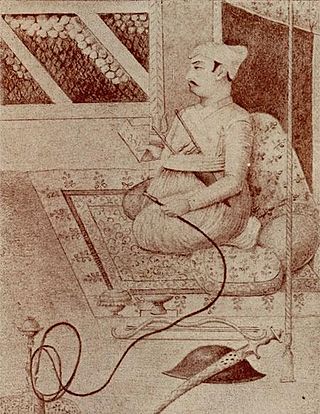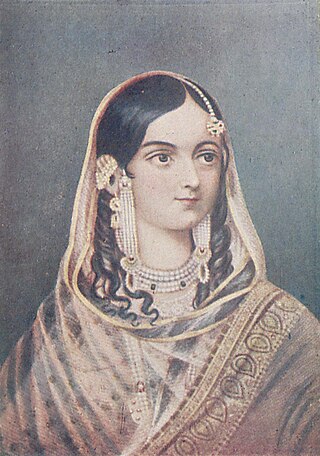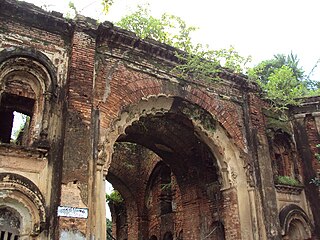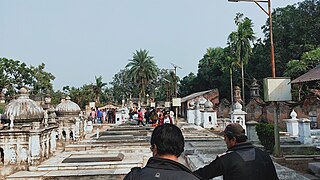
The Battle of Plassey was a decisive victory of the British East India Company, under the leadership of Robert Clive, over the Nawab of Bengal and his French allies on 23 June 1757. Robert Clive was paid £1 million by the Jagat Seth family - a rich Indian family business group - to defeat Siraj-ud-Daulah. The victory was made possible by the defection of Mir Jafar, Nawab Siraj-ud-Daulah's commander in chief who was also paid by the Jagat Seths. The battle helped the British East India Company take control of Bengal in 1772. Over the next hundred years, they continued to expand their control over vast territories in the rest of the Indian subcontinent, including Burma.

Mirza Muhammad Siraj-ud-Daulah, commonly known as Siraj-ud-Daulah or Siraj ud-Daula, was the last independent Nawab of Bengal. The end of his reign marked the start of the rule of the East India Company over Bengal and later almost all of the Indian subcontinent.

Murshidabad is a historical city in the Indian state of West Bengal. It is located on the eastern bank of the Bhagirathi River, a distributary of the Ganges. It forms part of the Murshidabad district.
Rajmahal is a subdivisional town and a notified area in Rajmahal subdivision of the Sahebganj district in the Indian state of Jharkhand. It is situated at the banks of Ganges and was former capital of Bengal Subah under Mughal governor, Man Singh I.

The Nawab of Bengal was the hereditary ruler of Bengal Subah in Mughal India. In the early 18th-century, the Nawab of Bengal was the de facto independent ruler of the three regions of Bengal, Bihar and Orissa which constitute the modern-day sovereign country of Bangladesh and the Indian states of West Bengal, Bihar and Odisha. The Bengal Subah reached its peak during the reign of Nawab Shuja-ud-Din Muhammad Khan. They are often referred to as the Nawab of Bengal, Bihar and Orissa. The Nawabs were based in Murshidabad which was centrally located within Bengal, Bihar, and Odisha. Their chief, a former prime minister, became the first Nawab. The Nawabs continued to issue coins in the name of the Mughal Emperor, but for all practical purposes, the Nawabs governed as independent monarchs. Bengal continued to contribute the largest share of funds to the imperial treasury in Delhi. The Nawabs, backed by bankers such as the Jagat Seth, became the financial backbone of the Mughal court.

Mir Syed Jafar Ali Khan Bahadur was a commander-in-chief or military general who reigned as the first dependent Nawab of Bengal of the British East India Company. His reign has been considered by many historians as the start of the expansion of British control of the Indian subcontinent in Indian history and a key step in the eventual British domination of vast areas of pre-partition India.

Mir Qasim was the Nawab of Bengal from 1760 to 1763. He was installed as Nawab with the support of the British East India Company, replacing Mir Jafar, his father-in-law, who had himself been supported earlier by the East India Company after his role in winning the Battle of Plassey for the British. However, Mir Jafar eventually ran into disputes with the East India Company and attempted to form an alliance with the Dutch East India Company instead. The British eventually defeated the Dutch at Chinsura and overthrew Mir Jafar, replacing him with Mir Qasim. Qasim too later fell out with the British and fought against them at Buxar. His defeat has been suggested as a key reason in the British becoming the dominant power in large parts of North and East India.

Jiaganj Azimganj is a city and a municipality in Murshidabad district in the Indian state of West Bengal.

Alivardi Khan was the fourth Nawab of Bengal from 1740 to 1756. He toppled the Nasiri dynasty of Nawabs by defeating Sarfaraz Khan in 1740 and assumed power himself.

Sarfarāz Khān, born Mīrza Asadullāh, was a Nawab of Bengal. Sarfaraz Khan's maternal grandfather, Nawab Murshid Quli Khan of Bengal nominated him as the direct heir to him as there was no direct heir. After Murshid Quli's death in 1727, Sarfaraz ascended to the Masnad (throne) of the Nawab. Sarfaraz's father, Shuja-ud-Din Muhammad Khan, then the Subahdar of Orissa, getting to know it arrived at Murshidabad, the capital of the Nawabs of Bengal with a huge army. To avoid a conflict in the family the dowager Begum of the Nawab asked Shuja-ud-Din to ascend to the Masnad after Sarfaraz abdicated in favour of his father. However, circumstances led Shuja-ud-Din to nominate Sarfaraz as his heir and after Shuja-us-Din's death in 1739, Sarfaraz Khan again ascended to the Masnad as the Nawab of Bengal.

Shuja-ud-Din Muhammad Khan was the second Nawab of Bengal, Bihar and Orissa. He married Zainab un-nisa Begum and Azmat un-nisa Begum, the daughters of Murshid Quli Khan by Nasiri Banu Begum. Shuja-ud-Din's third wife was Durdana Begum Sahiba. After the death of his father-in-law on 30 June 1727, he ascended to the Masnad (throne) of the Nawab.

Murshidabad-Jiaganj is a community development block that forms an administrative division in the Lalbag subdivision of Murshidabad district in the Indian state of West Bengal.

Mehar un-Nisa Begum, better known as Ghaseti Begum, was the eldest daughter of Alivardi Khan, Nawab of Bengal, Bihar and Orissa during 1740–1756.

Namak Haram Deorhi was the palace of Mir Jafar. It is located just opposite to the Jafarganj Cemetery in the Lalbagh area of the town of Murshidabad and near Mahimapur in the Indian state of West Bengal. Namak Haram Deorhi refers to both the place of Mir Jafar and the main gate which leads to the palace. This building was used as the residence of Mir Jafar, before he ascended the musnad of Bengal or when he was the Commander-in-Chief of the subha.

Jafarganj Cemetery is located in Murshidabad, West Bengal, India.

Khushbagh is the garden-cemetery of the Nawabs of Bengal, situated on the west bank of the Hooghly river, about a mile from its east bank, in the Murshidabad-Jiaganj CD block in Lalbag subdivision of Murshidabad district, West Bengal, India. Khushbagh hosts the graves of the Nawabs of Bengal of the Afshar dynasty and their family members; while Jafarganj Cemetery hosts the graves of the later Nawabs and their families, starting from Mir Jafar, who belonged to the Najafi dynasty. Khushbagh is the resting place of Nawab Siraj ud-Daulah, his wife Lutf-un-nisa, Nawab Alivardi Khan, and his mother, amongst others.

Lutfunnisa Begum was the 3rd wife and primary consort of Siraj ud-Daulah, the last independent Nawab of Bengal.

Amina Begum was a Bengali aristocrat from the Nawab family of Bengal and mother of Siraj ud-Daulah, the last independent Nawab of Bengal.
Ghulam Hussain Khan also known as Ghulam Husain Khan Tabatabai (1727/28-1797/98) was an 18th century Indian historian and scholar-administrator from Delhi who later settled in Azimabad (Patna). He is the writer of the famous book Seir Mutaqherin, one of the notable contemporary historical accounts on the late Mughal Empire.

Jama Masjid is a congregational mosque located at Motijhil, in the historic city of Murshidabad, West Bengal, India.






























